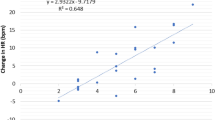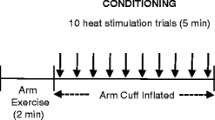Abstract
The study investigated the effects of expectancy on the reduction of cold pressor test pain using heart rate biofeedback training. Thirty-six male subjects were given an initial 45-sec cold pressor test, 25 heart rate decrease feedback training trials, and a final cold pressor test in which they were told to decrease their heart rate, but without the aid of feedback. Two levels of outcome expectancy (increase pain, decrease pain) and two levels of cold pressor water temperature (0°C, 5°C), resulting in four groups (N=9 per group), were used to assess the interaction between expectancy and aversive stimulus intensity. Immediately prior to the final cold pressor test, the increase pain expectancy subjects were told that decreasing their heart rate during the ice water immersion would cause more pain. Decrease pain subjects were told that decreasing their heart rate would cause less pain. Expectancy was found to be the major determinant of pain reports. The decrease pain subjects consistently reported less pain on the final cold pressor, whereas the increase pain subjects consistently reported more pain. Contrary to prediction, expectancy effects were greater for the colder water. The findings indicate the importance of expectancy in the clinical use of biofeedback to control pain.
Similar content being viewed by others
References
Barber, T. X., & Hahn, K. W. (1962). Physiological and subjective responses to pain producing stimulation under hypnotically suggested and waking-imagined “analgesia.”Journal of Abnormal and Social Psychology, 65 411–418.
Beatty, J. (1982). Biofeedback in the treatment of migraine: Simple relaxation or specific effects. In L. White & B. Tursky (Eds.),Clinical biofeedback: Efficacy and mechanisms (pp. 211–221). New York: Guilford.
Bowers, K. S. (1968). Pain, anxiety, and perceived control.Journal of Consulting and Clinical Psychology, 32 596–602.
Cox, D. J., & Hobbs, W. (1982). Biofeedback as a treatment for tension headaches. In L. White & B. Tursky (Eds.),Clinical biofeedback: Efficacy and mechanisms (pp. 338–357). New York: Guilford.
Davidson, R. J., & Schwartz, G. E. (1976). The psychobiology of relaxation and related states: A multiprocess theory. In D. I. Mostofsky (Ed.),Behavior control and modification of physiological activity (pp. 399–442). Englewood Cliffs, New Jersey: Prentice-Hall.
Evans, M. B., & Paul, G. L. (1970). Effects of hypnotically suggested analgesia on physiological and subjective responses to cold stress.Journal of Consulting and Clinical Psychology, 35 362–371.
Gracely, R. H., MacGrath, P., & Dubner, R. (1978). Ratio scales of sensory and affective verbal pain descriptors.Pain, 5 5–18.
Hilgard, E. R., Morgan A. H., Lange A. F., Lenox J. R., Macdonald, H., Marshall, G. D., & Sachs, L. B. (1974). Heart rate changes in pain and hypnosis.Psychophysiology, 11 692–702.
Hilgard, E. R., Morgan, A. H., & Macdonald, H. (1975). Pain and dissociation in the cold pressor test: A study of hypnotic analgesia with “hidden reports” through automatic keypressing and automatic talking.Journal of Abnormal Psychology, 84 280–289.
Hirschman, R., & Clark, M. (1983). Bogus physiological feedback. In J. T. Cacioppo & R. R. Petty (Eds.),Social psychophysiology: A sourcebook (pp. 197–214). New York: Gullford.
Lang, P. J. (1974). Learned control of human heart rate in a computer directed environment. In P. A. Obrist, A. H. Black, J. Brener, & L. V. DiCara (Eds.),Cardiovascular psychophysiology—Current issues in response mechanisms, biofeedback and methodology (pp. 392–405), Chicago: Aldine.
Lang, P. J., Rice, D. C., & Sternbach, R. A. (1972). The psychophysiology of emotion. In N. S. Greenfield & R. A. Sternbach (Eds.),Handbook of psychophysiology (pp. 623–643). New York: Holt, Rinehart & Winston.
Lykken, D. T., & Venables, P. H. (1971). Direct measurement of skin conductance: A proposal for standardization.Psychophysiology, 8 656–672.
Mandler, H., Mandler, J. M., & Uviller, E. (1958). Autonomic feedback: The perception of autonomic activity.Journal of Abnormal and Social Psychology, 56 367–373.
Reeves, J. L., & Shapiro, D. (1982). Heart rate biofeedback and cold pressor pain.Psychophysiology, 19 393–403.
Reeves, J. L., & Shapiro, D. (1983). Heart rate reactivity to cold pressor stress following biofeedback training.Biofeedback and Self-Regulation, 8 87–99.
Reeves, J. L., Shapiro, D., & Cobb, L. F. (1979). Relative influences of heart rate biofeedback and instructional set in the perception of cold pressor pain. In N. Birbaumer & H. D. Kimmel (Eds.),Biofeedback and Self-Regulation (pp. 355–376). Hillsdale, New Jersey: Erlbaum.
Scott, J., & Huskisson, E. C. (1976). Graphic representation of pain.Pain, 2 175–184.
Sirota, A. D., Schwartz, G. E., & Shapiro, D. (1974). Voluntary control of human heart rate: Effect on reaction to aversive stimulation.Journal of Abnormal Psychology, 83 261–267.
Stern, J. A., Brown, M., Ulett, G. A., & Sletten, I. (1977). A comparison of hypnosis, acupuncture, morphine, Valium, aspirin, and placebo in the management of experimentally induced pain. In W. E. Edmonston, Jr. (Ed.),Annals of the New York Academy of Sciences, 175–193.
Surwit, R. S. (1982). Biofeedback and the behavioral treatment of Raynaud's disease. In L. White & B. Tursky (Eds.),Clinical biofeedback: Efficacy and mechanisms (pp. 222–232). New York: Guilford.
Victor, R., Mainardi, J. A., & Shapiro, D. (1978). Effects of biofeedback and voluntary control procedures on heart rate and perception of pain during the cold pressor test.Psychosomatic Medicine, 40 216–225.
Winer, B. J. (1962).Statistical principles in experimental design (p. 322). New York: McGraw-Hill.
Wolf, S. L., Nacht, M., & Kelly, J. L. (1982). EMG feedback training during dynamic movement for low back pain patients.Behavior Therapy, 13 395–406.
Author information
Authors and Affiliations
Additional information
This research was supported by National Institute of Mental Health Research Grant MH-26923. Computing assistance was provided by the Office of Academic Computing, UCLA. We would like to thank Lisa Greenstadt, John Richards, John Reeves, and Barbara Smith for their assistance.
Rights and permissions
About this article
Cite this article
Subotnik, K.L., Shapiro, D. Heart rate biofeedback and cold pressor pain: Effects of expectancy. Biofeedback and Self-Regulation 9, 55–75 (1984). https://doi.org/10.1007/BF00998846
Issue Date:
DOI: https://doi.org/10.1007/BF00998846




